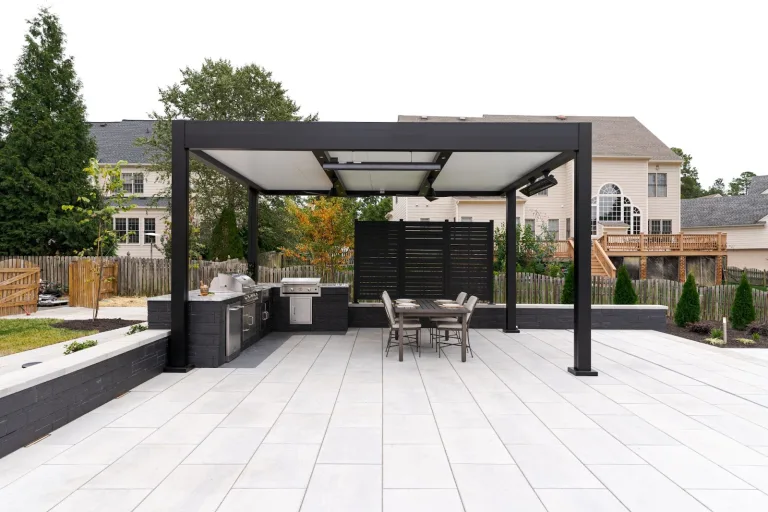Pergolas are a beautiful way to enhance an outdoor space, offering shade and style. But does a pergola need to be anchored? The short answer is yes, in most cases. Proper anchoring ensures stability, safety, and durability, preventing potential damage from strong winds or shifting ground. Whether installing a freestanding or attached pergola, choosing the right anchoring method is essential for a long-lasting structure.
Table of Contents
Is It Necessary to Anchor a Pergola?
Anchoring a pergola is crucial to maintaining its structural integrity. Without proper anchoring, pergolas can shift, tilt, or even collapse under external forces like wind and rain.
A secure pergola remains stable and protects your investment. The materials used, such as aluminum, wood, or steel, also determine the anchoring requirements. While heavier materials may provide better grounding, they still need reinforced footings to withstand unpredictable weather.
Understanding Pergola Stability
A pergola provides shade and enhances outdoor spaces, but it must be properly secured to avoid instability. The level of pergola stability depends on various factors, including the material, weight, and ground surface.
- Aluminum pergolas are lightweight and require secure anchors to prevent movement.
- Wooden pergolas are heavier but still benefit from additional stabilization.
- Steel pergolas are robust but need solid footings to prevent shifting.
Choosing the right material influences the need for anchoring. A well-secured pergola ensures longevity and performance, making it a reliable addition to your home.
Factors That Influence the Need for Anchoring
Several factors determine whether a pergola requires anchoring:
- Weather Conditions – High winds, storms, or heavy snowfall make anchoring essential.
- Pergola Design and Weight – Lightweight materials like aluminum pergolas require stronger anchors than heavier wooden models.
- Intended Use and Location – A pergola installed on a patio may need a different anchoring approach than one placed in an open backyard.
When Is Anchoring Necessary?
Not all pergolas need the same anchoring solutions. Understanding when anchoring is required helps prevent costly repairs or damage.
Free-Standing Pergolas vs. Attached Pergolas
- Attached pergolas connect to a wall for extra support but may still require ground anchors.
- Freestanding pergolas need secure anchoring to avoid shifting, especially in open areas exposed to wind.
Local Building Codes and Permits
Checking local building codes is crucial before installing a pergola. Some areas require specific post footings and anchoring methods to meet safety regulations. Failure to comply with building codes for pergolas can result in fines or forced removal.
Safety and Longevity Considerations
An unanchored pergola can become hazardous in strong winds. Proper anchoring extends its lifespan by reducing stress on the structure, preventing tilting or collapse. Investing in secure installation methods enhances safety and long-term durability.
Does a pergola need to be anchored? Ensuring proper anchoring is critical to preventing structural damage and increasing the pergola’s lifespan.
Different Methods to Anchor a Pergola
Several anchoring methods ensure pergola stability, each with its own benefits and considerations.
Concrete Footings
Concrete footings are the most reliable way to anchor a pergola.
- Process: Pergola posts are embedded into deep concrete footings for maximum stability.
- Benefits: Offers long-lasting support, ideal for high-wind areas.
- Considerations: Requires drilling and proper depth for effectiveness.
Metal Post Anchors and Brackets
Post brackets secure pergola posts to concrete slabs or decks, offering stability without major excavation.
- Best for: Locations where digging isn’t an option.
- Pros: Easy installation, minimal ground disturbance.
- Cons: May not provide as much support as deep footings.
Ground Anchors for Soft Soil Installation
Ground anchors secure pergola posts deep into the soil, acting as a firm base for stability.
- Ideal for: Temporary or semi-permanent pergolas.
- Pros: No need for concrete; easy to remove.
- Cons: Less durable in extreme weather conditions.
Weighted Planters as an Alternative
For those who prefer a non-invasive approach, weighted planters filled with gravel or concrete offer a creative solution.
- Best for: Renters or individuals avoiding pergola drilling into patios or decks.
- Pros: Portable and decorative.
- Cons: May not be suitable for extreme weather conditions.
Anchoring Considerations for Azenco Outdoor Pergolas
All Azenco Outdoor pergolas require secure anchoring, with the method varying based on design, engineering, and site conditions. Factors like ground surface and weather exposure determine the best approach.
For structural stability, models like the R-BLADE™, R-SHADE™, and R-BREEZE™ require anchoring, particularly in high-wind areas. In contrast, the K-BANA™ offers more flexibility, as it may not need anchoring in certain locations. As for the K-NOPY™, it follows a different approach, relying on wall mounting rather than ground anchoring for support.
Regardless of the model, proper installation based on site-specific conditions is essential for long-term reliability and performance. By working with professionals, each pergola can be securely installed to meet structural and safety standards, ensuring lasting durability and functionality.
Things to Consider Before Choosing an Anchoring Method
Choosing the right anchoring method depends on several factors.
Type of Ground Surface
- Concrete slabs require anchor pergola drilling and secure brackets.
- Soil installations need deep ground anchors or concrete footings.
- Pavers may require additional stabilization techniques.
Structural Load and Weight of the Pergola
- Heavier pergolas require deeper, more secure footings.
- Lightweight aluminum pergolas need additional post footings for extra stability.
Compliance with Local Building Codes
Before installing a pergola, homeowners should check local building codes to ensure compliance. If unsure, consulting a professional installer is a good idea.
Conclusion
So, does a pergola need to be anchored? In most cases, the answer is yes. Anchoring a pergola enhances safety, durability, and compliance with local regulations. Whether using concrete footings, ground anchors, or post brackets, selecting the right anchoring method depends on the location, material, and surface type.
Frequently Asked Questions
Can a pergola be freestanding without anchoring?
How do you stabilize a freestanding pergola?
Stabilizing a freestanding pergola involves anchoring its posts securely to the ground. Common methods include:
- Concrete Footings: Embedding posts into concrete footings provides a solid and permanent base.
- Ground Anchors: Spiral or helical ground anchors can be driven into the soil to secure the structure.
- Weighted Bases: Using heavy planters or concrete blocks at the base of each post can add stability, especially on hard surfaces.
The choice of method depends on the pergola’s location, size, and intended permanence.
Does a pergola need to be secured to the ground?
Yes, securing a pergola to the ground is crucial for its longevity and safety. Anchoring prevents the structure from shifting or collapsing due to wind loads or uneven settling. It also ensures compliance with local building codes and regulations, which often require permanent outdoor structures to be properly secured.
How do you anchor a freestanding pergola?
Anchoring a freestanding pergola can be achieved through various methods:
- Concrete Footings: Digging holes for each post and filling them with concrete provides a durable anchor.
- Post Brackets: Attaching metal brackets to existing concrete slabs or decks allows for the secure fastening of pergola posts.
- Ground Anchors: For installations on soil, ground anchors can be used to tie down the structure effectively.
Each method should be chosen based on the specific site conditions and structural requirements.
Are there non-invasive methods to anchor a pergola?
Yes, for situations where drilling or permanent alterations are not feasible, non-invasive anchoring methods include:
- Weighted Planters: Placing heavy planters filled with soil or concrete at the base of each post can provide stability.
- Concrete Blocks: Using precast concrete blocks to weigh down the structure is another alternative.
- Sandbags: For temporary setups, sandbags can be used to prevent movement.
While these methods offer flexibility, they may not provide the same level of security as permanent anchoring solutions.



2 Responses
I came across your ad and would like to know more.
I noticed your advertisement. Please reach out to me.
Good morning Michael,
I just sent you an email!